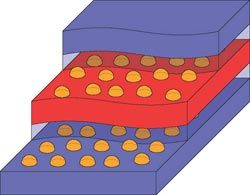A Quantum Dot Energy Harvester: Turning Waste Heat into Electricity on the Nanoscale

An array on nano energy harvesters in what the researchers call a "swiss cheese" arrangement.<br>
“The system is really a simple one, which exploits certain properties of quantum dots to harvest heat,” Professor Andrew Jordan of the University of Rochester said. “Despite this simplicity, the power it could generate is still larger than any other nanoengine that has been considered until now.”
The engines would be microscopic in size, and have no moving parts. Each would only produce a tiny amount of power – a millionth or less of what a light bulb uses. But by combining millions of the engines in a layered structure, Jordan says a device that was a square inch in area could produce about a watt of power for every one degree difference in temperature. Enough of them could make a notable difference in the energy consumption of a computer.
A paper describing the new work is being published in Physical Review B by Jordan, a theoretical physics professor, and his collaborators, Björn Sothmann and Markus Buttiker from the University of Geneva, and Rafael Sánchez from the Material Sciences Institute in Madrid.
Jordan explained that each of the proposed nanoengines is based on two adjacent quantum dots, with current flowing through one and then the other. Quantum dots are manufactured systems that due to their small size act as quantum mechanical objects, or artificial atoms.
The path the electrons have to take across both quantum dots can be adjusted to have an uphill slope. To make it up this (electrical) hill, electrons need energy. They take the energy from the middle of the region, which is kept hot, and use this energy to come out the other side, higher up the hill. This removes heat from where it is being generated and converts it into electrical power with a high efficiency.
To do this, the system makes use of a quantum mechanical effect called resonant tunneling, which means the quantum dots act as perfect energy filters. When the system is in the resonant tunneling mode, electrons can only pass through the quantum dots when they have a specific energy that can be adjusted. All other electrons that do not have this energy are blocked.
Quantum dots can be grown in a self-assembling way out of semiconductor materials. This allows for a practical way to produce many of these tiny engines as part of a larger array, and in multiple layers, which the authors refer to as the Swiss Cheese Sandwich configuration (see image).
How much electrical power is produced depends on the temperature difference across the energy harvester – the higher the temperature difference, the higher the power that will be generated. This requires good insulation between the hot and cold regions, Jordan says.
Contact: Leonor Sierra
lsierra@ur.rochester.edu
585.276.6264
About the University of Rochester
The University of Rochester (www.rochester.edu) is one of the nation's leading private universities. Located in Rochester, N.Y., the University gives students exceptional opportunities for interdisciplinary study and close collaboration with faculty through its unique cluster-based curriculum. Its College, School of Arts and Sciences, and Hajim School of Engineering and Applied Sciences are complemented by its Eastman School of Music, Simon School of Business, Warner School of Education, Laboratory for Laser Energetics, School of Medicine and Dentistry, School of Nursing, Eastman Institute for Oral Health, and the Memorial Art Gallery.
Media Contact
All latest news from the category: Physics and Astronomy
This area deals with the fundamental laws and building blocks of nature and how they interact, the properties and the behavior of matter, and research into space and time and their structures.
innovations-report provides in-depth reports and articles on subjects such as astrophysics, laser technologies, nuclear, quantum, particle and solid-state physics, nanotechnologies, planetary research and findings (Mars, Venus) and developments related to the Hubble Telescope.
Newest articles

A universal framework for spatial biology
SpatialData is a freely accessible tool to unify and integrate data from different omics technologies accounting for spatial information, which can provide holistic insights into health and disease. Biological processes…

How complex biological processes arise
A $20 million grant from the U.S. National Science Foundation (NSF) will support the establishment and operation of the National Synthesis Center for Emergence in the Molecular and Cellular Sciences (NCEMS) at…

Airborne single-photon lidar system achieves high-resolution 3D imaging
Compact, low-power system opens doors for photon-efficient drone and satellite-based environmental monitoring and mapping. Researchers have developed a compact and lightweight single-photon airborne lidar system that can acquire high-resolution 3D…





















